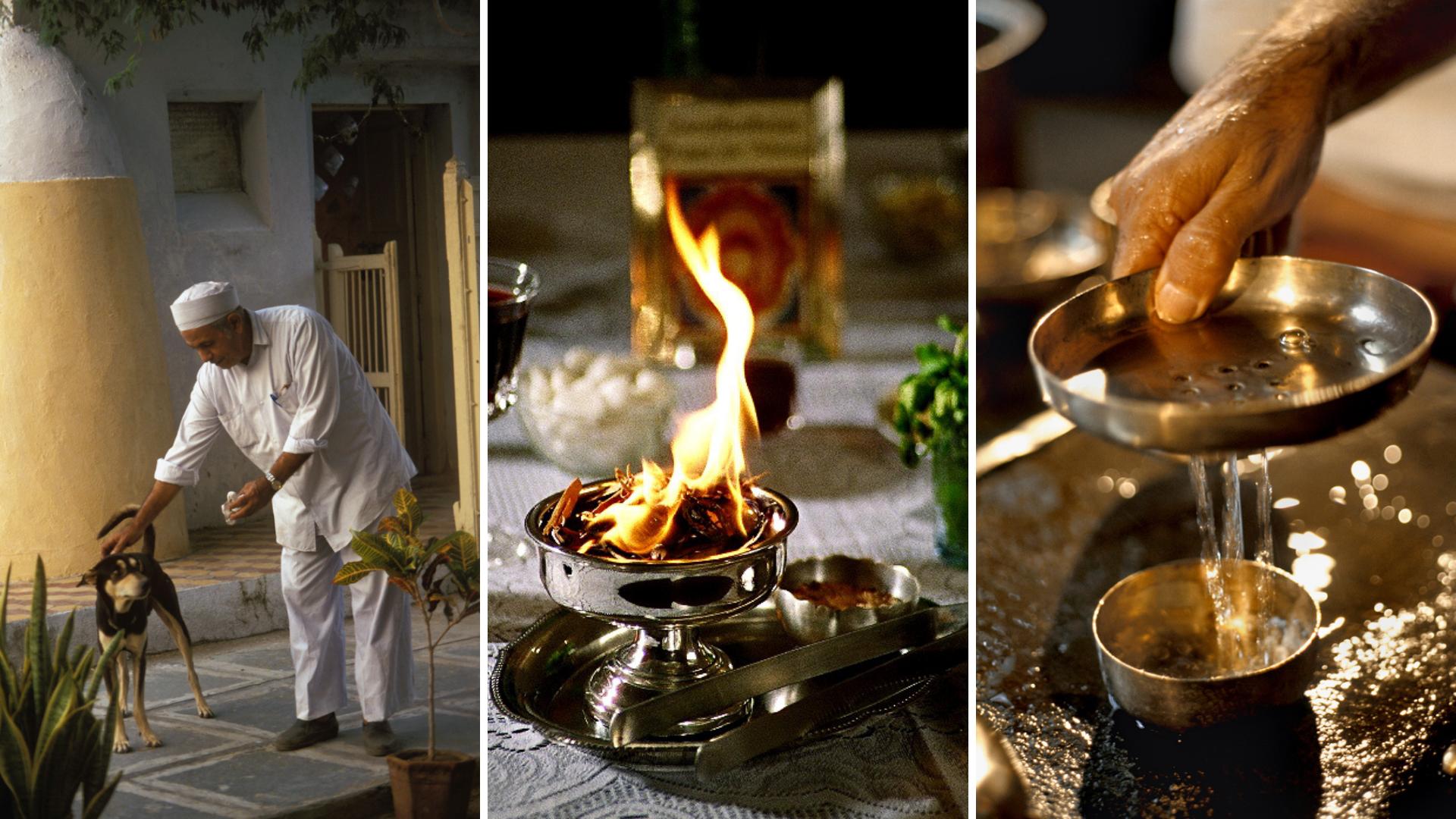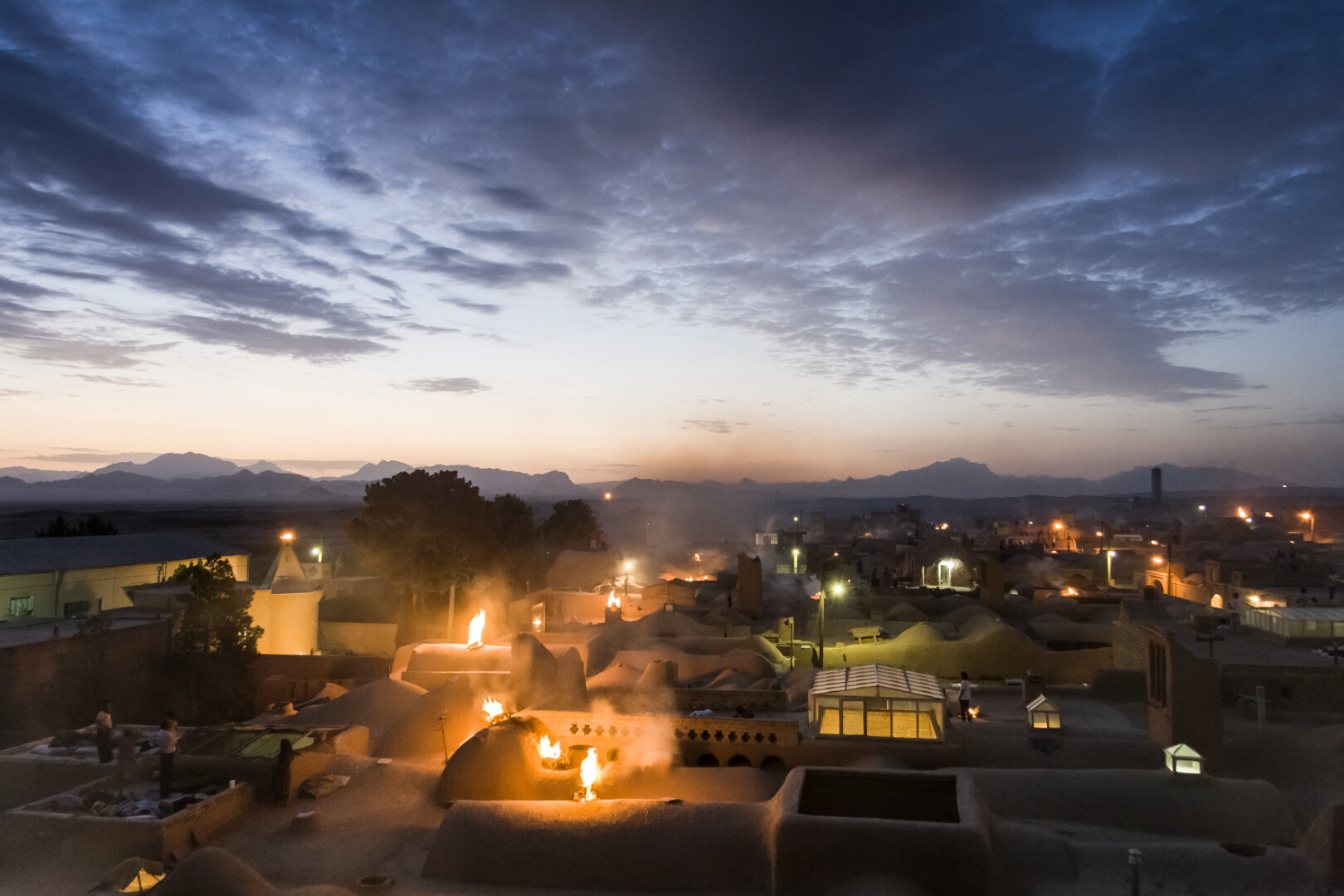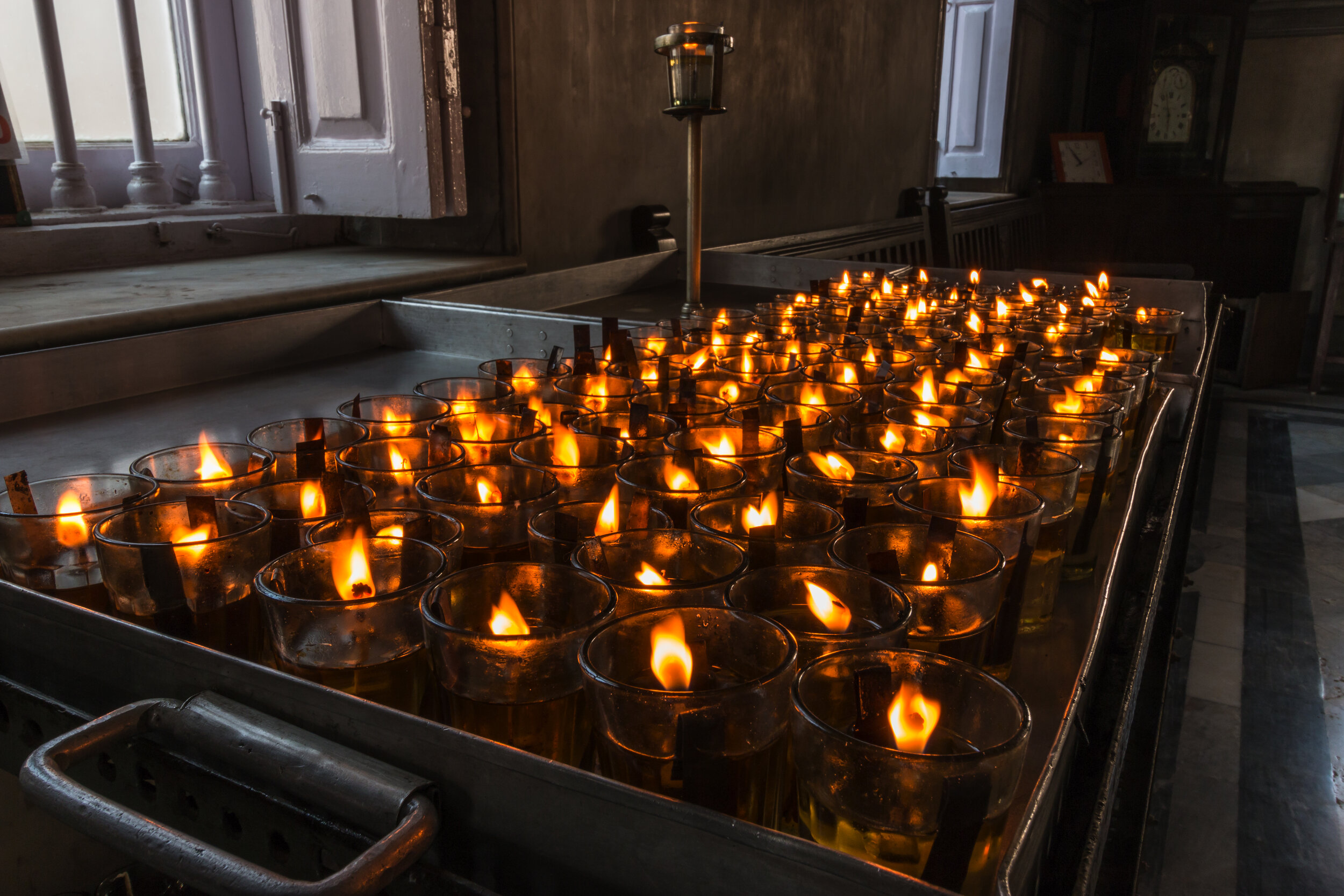
Ecology & Society
“For when he commits sin against water and vegetation,
even when it is committed against merely a single twig of it,
and he has not atoned for it when he departs from the world,
the spirits of all the plants in the world stand
up high in front of that man and do not let him go to heaven.”
- Zoroastrian Pahlavi Text
"He who sows corn sows righteousness"
-Vendidad; Bardoli Village
Zoroastrianism is regarded as a unique ecological religion. Ecology, from the Greek word oikos (home), is that branch of biology that deals with the interdependent relationship of organisms to their surroundings. In Zoroastrianism, respect for each aspect of creation is a cardinal tenet of the faith. In the Gathas (Ys. 29) Gaush Urva, the Soul of Creation, calls out in anguish for a saviour. Zarathushtra, comes to earth to ensure total justice and righteousness for all creation. He preaches the divine law of Asha or Cosmic Truth, which is not just for human beings, but for every aspect of creation. Every aspect of being must be treated with justice, such justice ensures harmony. Harmony can only be possible when there is no exploitation or degradation of creation.
The universe or Spenta is good and bountiful, and Zoroastrian texts encourage one to use thor Good Mind or Vohu Manah to move all creation towards perfection. For the Zoroastrian faith, all creation is sacred, and the Earth is Sacred space- this translates into care for our planet, the environment, and all creatures inhabiting it. A Zoroastrian’s life on earth is a forum for conscience and choice. Wasting any resource is theft, pollution is an act of violence against our Sacred space. Asha, or the cosmic law of righteousness or truth must govern the life of a Zoroastrian.
“Asha is the only path to the divine, and creating cosmic harmony is a sacred duty. “
In January 2004 Parzor released a movie “Asha – The Law of Harmony”
In this movie on Asha, the Bronze Age ritual of the Yasna and the Jashan ceremony are enacted and their environmental significance explained.
PARZOR ‘s Award-winning video submission to the multi-national candidature of Navroze in the representative list of the Intangible Culture of Humanity.
Ecology & Conservation
In the 21st century, we are still struggling to achieve human rights. In the Bronze Age, prophet Zarathushtra, spoke in the Gathas, of the rights of plants and animals, minerals and waters, of reverence and nurture of all Spenta (Bounteous) Creation. Zoroaster was the Ratu, the enlightened Guide, whose teachings would lead all being to salvation. His belief in a cosmic law led him to create a theology by which he ensured that all his followers would treat nature with reverence and fight pollution, degradation and disorder. The philosophy of the religion stresses choice and human responsibility in processes of all life cycle rituals from birth to death. Complete freedom is given to the individual. The path of Asha exists, but each individual has to choose the path he wants to follow.
During the life cycle rituals, from birth to death all aspects of creation are invoked in rituals. In childhood, at the Navjote a child chooses to be a Hamkar or fellow worker of God, a soldier of truth accepting responsibility for actions and decisions. He is invested with the white Sudreh, the shirt of the right path and the Kusti or sacred thread, the girdle, which becomes part of his armour as a soldier of Truth or Asha fighting the Lie or Druj. Fire is present at the initiation and the child receives the blessings of the plant world when rice, pomegranate seeds, rose petals are showered upon him to bless him with long life, good health and happiness. Green the color of new life is used in Iran for the Navjote cap and again calls upon nature to give its blessings to the child.
The Char Disha-No-Namaskar (Salutation to the four directions), the Jamvani Baj (Grace before meals) the Kutra no Buk (the Morsel for the dog) and other daily actions are celebrations of the unity of the web of life. Traditionally, even before planting a seedling in the earth, the man held the plant in both hands and slowly turned to the four directions, offering the plant to sun and shadow, wind and rain, moonlight, and the birds and animals. The words recited were “Nemo Ve Urvaro, Mazdadathe Ashone”, “Homage to you O’ Good and sacred plant created by Mazda” and were followed by the Ashem Vohu prayer.
The six Gahambars, seasonal festivals of the pastoral and farming year that invoke the blessings of all aspects of creation are linked with the seventh festival, Navroze of the Zoroastrian New Year. The Navroze or Haft Seen table gathers, in one sacred space, aspects of nature in a joyous welcoming of the New Year. The Gahambars with Navroze create a chain of seven feasts in honour of the Amesha Spenta and the seven creations. The importance of these feasts is that they remain Zoroastrian holy days of obligations. Their celebration was considered meritorious and failure to observe them was a sin.
Like the Sudreh and Kusti these holy days have sustained the traditions of the community. Everyone was expected to contribute something, the rich and the poor alike attended the banquet and this was a time of great faith and communal bonding. As Ahura Mazda’s own creation, man has a special duty to the six lesser creations. The ethical code, which the doctrine embodies, gives man a unique sense of responsibility towards the earth and all created being. The duties enjoined on Zoroastrians to protect the environment, nurture trees and plants, care for animals, enrich the soil and keep earth, water and fire unpolluted can all be seen stemming from respect for the Amesha Spenta, protectors of all creations. Therefore, a comprehensive system of ethics and philosophy combines with the need for physical well being and responsibility to the environment.
In daily life, purity is to be carefully maintained all impurity or nasu must be disposed of with care- even hair trimmings and nail parings are contaminating and are disposed of with care so as to not pollute the earth. White lime Chalk is used at the doorstep of the house and the Parsis of India have created elaborate designs with which they decorate their homes. It is traditionally believed that white lime welcomes the spirits of Fravashis and guides them to the Zoroastrian hearth and home. In Iran lime is sprinkled from the doorstep till the hearth fire or place of the Afarganyu fire vase on ritual occasions. Thus purity and cleanliness become not just domestic virtues but acquire religious significance, thus at both levels ensuring care for the environment.
The bond between the material and spiritual worlds is maintained in all Zoroastrian life cycle rituals even continuing beyond into the spirit world. In the ten days before the New Year, when it is believed that the spirits of the dead descend to their family homes, (Muktad among the Gujarati speaking Zoroastrians and the festival of All Souls or Fravardigan, the Avestan Hamaspathmaedaya among the Iranian peoples), the spirits are welcomed by the scent of incense and sweet flowers, by fire and ritual offerings of food. Special silver vases each inscribed with the name of the dead family member are filled with flowers during these days of observance. On the last night of the festival, the Fravashis or spiritual essences, are bidden a formal farewell by their living relatives and are sent to their heavenly abode with prayers, burning incense and in Iran specially lighted fires on roof tops to guide them on their journey.
There are no cycles of rebirth in Zoroastrianism by which a man can work out his karma, nor is there a Saviour who will bear the cross for the sins of humankind. According to Zoroastrian theology each human being has within himself an Urvan, often translated as “soul”, but whose literal meaning “The Chooser”, conveys its significance much accurately. Thus, it is seen that in all the life cycle rituals care of creation plays a constant and vital role. It is through this that the philosophy and theology of the unity of all creation becomes a part of the living Zoroastrian tradition. The Zoroastrian is conscious of serving Ahura Mazda and the Amesha Spentas in daily actions. There is a religious element behind the culture of care and concern in their dealings with water and earth, plants and animals. In Iran, it was this, which made the Zoroastrians renowned as good gardeners, farmers and stockmen. Thrift in using nature’s gifts and charity to all life is combined. Trees are venerated, to destroy a tree is a sin and water is reverenced, kept pure and never wasted. Zoroastrian respect for the environment always has the final aim of veneration of Ahura Mazda, the creator of all life.
AVA
Behistun at Dawn, showing vegetation, water and light- attributes of three of the Amesha Spenta.
The Zoroastrian Calendar, its rites and rituals stress environmental awareness and teach a holistic approach to daily life through the interweaving of all aspects of Ahura Mazda’s Good Creation. Reverence, care and compassion for the earth is inculcated primarily through the theology of the Amesha Spenta and Yazatas, divinities after whom each day of the month and each month of the calendar is dedicated. Since ancient times both fire and water have formed an indispensable part of Indo-Iranian rituals. Temples to Anaitis or Anahita, Spirit of water, have been found since the time of the Magi. To pollute water or pluck a flower after sunset, when it is resting, is a sin; to shield all life and to nurture all creation is the Zoroastrian creed.
Priests carrying well-water for the Yasna ceremony.
Zoroastrianism was born amidst barren mountains and cold deserts- this landscape gave rise to many of the concepts of the positive energy in water, vegetation and life which Zarathushtra expresses in his Songs. The holy Cypress tree in the village Cham, Yazd is venerated and towers over the landscape providing freshness in a dry region. In the calendar, Ava Parab, the birthday of the waters celebrates the sanctity and importance of water.
Qanat & Tanka Systems
The Iranian plateau, with mountains running north-west to south-east, a cold desert formed from a dried up sea, dense forests of oak, walnut, pistachio and valleys with figs, pomegranates, oranges, lemons and mulberries, is a region of contrasts. As forests gave way to pastures and later cultivation, it was seen that the ground of what is to a large extent, a cold desert, would yield abundantly wherever water was available. Wheat, barley, the opium poppy, cotton and tobacco grew and the country was artificially irrigated from pre historic times by a wide network of canals called Ghanat/Qanat or kariz. A quanāt is a gently sloping underground channel with a series of vertical access shafts, similar to that of a well, used to transport water from an aquifer under a hill. Quanāts create a reliable supply of water for human settlements and irrigation in hot, arid and semi-arid climates.
Zoroastrians, since these ancient quanats, were well known for their ability in protecting water and their ecological consciousness, particularly in connection with water systems, as is seen in the Gabarbands of Central Asia. Continuity in this tradition is observed in the Tanka system of Gujarat. While Gujarat is famous for its step wells and baolis, these are systems of gathering water. The unique water harvesting system of the Tanka provides pure drinking water at Parsi homes in Bharuch, South Gujarat. On analysis, this water meets WHO Water Quality Standards of purity.
Rituals
Yasna
Yasna (Sanskrit Yagna) from the Avestan root Yaz or Sanskrit Yag means ‘to invoke, worship, praise’. It is a prehistoric act of sacrifice performed to help strengthen the world. Believed to have its origin in the chief act of worship of the proto Indo-Iranians, this ceremony has maintained one of the great heritages of humanity. Once a daily prayer in the most sacred inner sanctum of the great Atash Behrams, today few priests regularly perform this ritual.
It starts before dawn with the drawing of water from a well and develops into a complex web of prayers, which bring the seven creations, the elements and the cosmos itself into a sacred space. There are no statues or icons here. The only objects of veneration are natural, as the priests bless and purify creation. Finally, after hours of intense chanting and symbolic ritual, the water, energized and consecrated, is poured back into the well in the light of the Sun.
The Yasna, drawing water from a well, bind together the seven creations – Fire, Water, Earth, Plant, Animal, Metal and Man, and completing the circle with the spiritually energized water poured back into the well, strengthens each day.
The festivals, rituals and texts of Zoroastrianism thus exemplify Zoroaster’s holistic vision and environmental consciousness. Recording of priests is a part of oral tradition recordings. Adar Roj, honoring fire, Bahman Mahino, paying respect to the animal world are just a few examples of the interconnectedness of all being.
Jashan
A Jashan, (the word a later derivative from the word Yasna) is a ritual which invokes Ahura Mazda, Fravashis, Sarosh Yazta and the divine being presiding over the day the ritual is performed. This is done through recitation of prayers accompanied by ritual gestures. Humans, animals, plants, water, metal, earth and fire- all seven creations- are present during the Jashan ritual. A pure white sheet is spread demarcating the area on the earth which is being consecrated. A fire is lit after an enthronement ceremony, the Jashan Mandvanu, and is fed throughout he ceremony.
The Atash Nyayesh, or the praise of fire, is recited in the ceremony to give physical warmth and mental enlightenment. The Atash Nyayesh is followed by the Dibacheh, which invokes those departed and calls them to be with their descendants during the Jashan. Three kardehs follow, invoking Ahura Maza, Dahma Yazata for blessings and Sarosh Yazata, the Yazata of prayer. A Jashan may be performed on any auspicious day for happiness, health and prosperity. It is also performed before a marriage where both families come together in prayer for harmony in the future.
Dokhmesani
A ritual, peculiar to the Parsi Zoroastrians, Dokhmesani is the last act of charity performed by a Zoroastrian, even after death. It is a final good deed, as the corpse feeds scavenger birds or vultures that need sustenance. Dead matter is seen as a pollutant or nasu, and the priestly tradition explains this ritual as being based on preventing nasu from defiling water, soil or fire. The soul is important, but now, after death the body does not matter. In the Dakhma, the sun takes care of the bones that remain, the decomposition is speedy and does not allow pollutants to affect Spenta creation. In the Dakhma, the sun takes care of the bones that remain after the scavengers have fed on the body and the decomposition is speedy.
The Dakhmas and the Dakhma complex in which they are located, e.g. the Bombay Doongerwadi (a place on a hill, in Gujarati) are situated away from settlements, usually on hilltops. Over the years, the complex incorporated a bangli, a small separate structure with housing facilities to perform ceremonies required as prescribed before consigning the body to the Tower. The family normally stays at this site for this period, as it is believed that the spirit remains on earth with its family before the crossing over. There is a ritual of placing a small oil lamp or divo in an opening in the structure of the bangli aligned with a small aperture made in the wall of Dakhma. This glimpse of light, it is said, comforts the soul through the darkness and distance.
While Parsis regard Dakhmas as ritually impure, in the Iranian cemetery, incense -typically Esfand, the grain of a wild mountain plant - perfumes the air while gifts of flowers and fruits are placed as acts of remembrance. Ceremonial food such as Ash, a green vegetable soup with noodles, siruk– sweet oil fried bread, lork – a mixture of dry fruit, nuts, milk, water and wine are all part of collective and individual funeral offerings, considered beneficial for the soul. While larger populations of Zoroastrians followed the Dakhma system in India and Iran till it was changed during reforms in Iran in the 20th century, smaller locations have followed the system of burial at Aramgahs- literally ‘resting place’. Here stone slabs are used to form a barrier during burial with Spenta Earth. However, this custom rarely exists today and coffins are now regularly used.
Festivals
Zoroastrians the world over follow three different variants of the ancient Iranian calendars- the Shahanshahi, Kadimi, and the Fasli. Despite their differences based on intercalation in comparison to the Gregorian calendar, the commonality, that all the 3 Iranian calendars are based on seasonal cycles, remains.
Zarathustra taught that all things flourish according to the law of reciprocity – the six holy festivals of the pastoral and farming year, known as the Gahanbars, remind man to celebrate and thank the elements, which make life possible. Each gahanbar represents one of Ahura Mazda's Amesha Spenta or a primordial creation and is celebrated during different times of the year.
Zoroastrians still celebrate the birthday of Fire as a special day– Adar Mahino Adar Roj, and Ava Mahino, Ava Roj is celebrated as the birthday of water. While these, are noteworthy, auspicious days or periods in the Zoroastrian calendar that are celebrated with small gestures and rituals in the home, there are also many festivals, other than the gahanbar periods, which bring families and communities together through the year.
Related Articles




